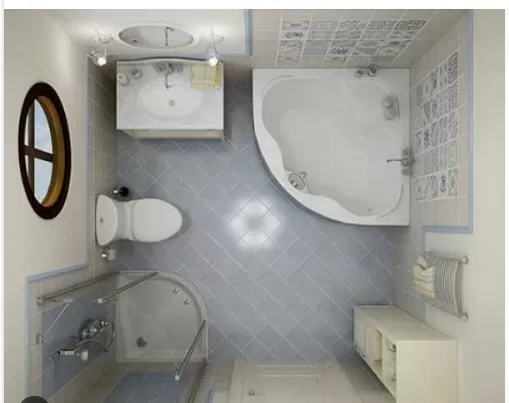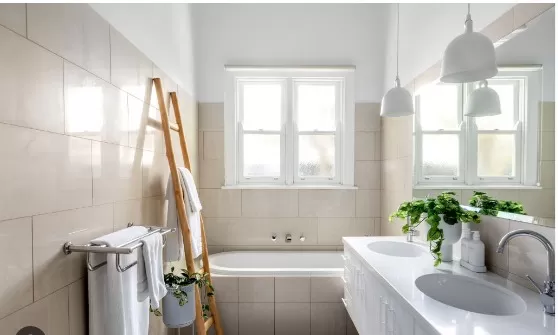Bathroom Remodeling Pitfalls: 5 Mistakes to Avoid. Bathroom remodeling can indeed be a significant investment, whether you’re simply replacing a vanity or undertaking a full-scale renovation.
However, with careful planning and smart decision-making, you can manage the costs and achieve a beautiful and functional bathroom within your budget.
Don’t Neglect the Importance of a Bathroom Exhaust Fan

When renovating your bathroom, it’s crucial not to overlook the significance of having a properly sized bathroom exhaust fan.
Many people tend to forget about this feature, but it plays a vital role in maintaining a healthy and functional bathroom environment. Without adequate ventilation, the enclosed space becomes a breeding ground for humidity, leading to various issues such as the growth of mold and mildew, as well as the deterioration of paint, grout, and metal fixtures.
Whether you already have a bathroom exhaust fan or plan to install one during your renovation, it’s essential to take certain steps to ensure its effectiveness.
Before turning on the fan in your updated space, make sure to thoroughly clean the vent, removing any construction dust and debris that may have accumulated. By doing so, you’ll optimize the performance of the fan and ensure that it efficiently eliminates moisture and odors from your bathroom.
Remember, a bathroom exhaust fan is not just a luxury but a necessity for maintaining a healthy and well-preserved bathroom.
So, don’t underestimate its importance and make sure to include it in your renovation plans.
The Importance of a Well-Defined Plan
When it comes to renovating your bathroom, having a clear and comprehensive plan is essential.
It’s crucial to avoid the common mistake of starting the project without a solid understanding of your bathroom’s specific requirements. By neglecting to plan ahead, you risk encountering unforeseen challenges and costly mistakes. Therefore, it is imperative to develop a well-thought-out plan that considers precise measurements, estimated costs, required materials, and your personal preferences.
One of the initial steps in creating your plan is to accurately measure the space you’ll be working with.
This includes the dimensions of the bathroom itself as well as individual fixtures such as the toilet, bathtub, and sink. By having precise measurements, you can ensure that any new additions or modifications will fit seamlessly into the available space.
Another crucial aspect of your plan is estimating the costs associated with the remodel.
Consider the expenses for materials, labor, permits, and any unforeseen expenses that may arise. Having a realistic budget in mind will help you make informed decisions and prevent overspending.
Furthermore, carefully choose the materials you’ll be using for your bathroom renovation.
Consider their durability, maintenance requirements, and aesthetic appeal. Research different options and compare prices to ensure that your choices align with your vision and budget.
Lastly, communicate your plan effectively to any family members or contractors who will be involved in the remodel.
Provide them with detailed information and visual representations, such as drawings or diagrams, to ensure everyone is on the same page. This will help streamline the renovation process and minimize confusion or errors.
Remember, a well-defined plan serves as a roadmap for your bathroom renovation project.
By investing time and effort into creating a comprehensive plan, you can minimize unexpected surprises, save costs, and achieve the bathroom of your dreams.
Prioritizing Functionality and Proper Spacing in Your Bathroom Renovation

When embarking on a bathroom renovation, it’s important to emphasize not only aesthetics but also functionality.
While the visual appeal is undoubtedly significant, it should not overshadow the importance of thoughtful layout and proper spacing. Before diving into the decorative aspects, it’s crucial to consider the practical aspects of the space to ensure a comfortable and functional bathroom.
When reimagining the layout of your bathroom, particularly if it involves demolishing walls or relocating plumbing fixtures, it’s essential to adhere to building codes and guidelines.
These codes specify minimum spacing requirements to ensure safety and accessibility. By following these regulations, you can create a bathroom that meets legal standards and avoids potential issues in the future.
In addition to compliance with building codes, you should also prioritize the everyday usability of the space.
Carefully consider the placement of fixtures and furnishings to optimize convenience and comfort. Think about how you use your bathroom on a daily basis and how the layout can facilitate those activities.
Ensure that there is enough space for movement and that the arrangement allows for easy access to essential elements like the toilet, sink, and shower/bathtub.
Proper spacing between fixtures is crucial to prevent overcrowding and promote efficient use of the space.
Consider the flow of traffic and ensure that there is enough room for individuals to move around comfortably. Adequate spacing will also make it easier to clean and maintain the bathroom in the long run.
While the decorative aspects of your renovation are important, it’s advisable to prioritize functionality and spacing during the planning phase.
By focusing on these elements first, you can create a bathroom that not only looks visually appealing but also offers a well-organized and comfortable environment for everyday use. Once the layout and spacing have been properly addressed, you can then proceed with the exciting task of decorating and adding the finishing touches to your renovated bathroom.
Selecting the Right Materials for Your Bathroom Renovation
When renovating your bathroom, it’s crucial to choose materials that can withstand the unique challenges posed by this high-moisture environment.
Bathrooms are subject to fluctuating temperatures, high humidity levels, and constant exposure to water. To ensure the longevity and durability of your renovation, it’s essential to select materials specifically designed for bathroom use.
One of the primary considerations is flooring.
Opt for materials that are moisture-resistant and can withstand exposure to water. Ceramic or porcelain tiles are popular choices due to their water resistance and durability.
They are also easy to clean and maintain. Another option is Vinyl Flooring, which is moisture-resistant and available in a wide range of styles.
Avoid materials like solid hardwood or carpet, as they are prone to warping, mold, and mildew in the humid bathroom environment.
When it comes to walls, choose materials that can withstand high humidity and are easy to clean.
Ceramic tiles are commonly used in bathroom walls due to their water resistance and ability to prevent moisture from seeping through. Other options include moisture-resistant paint or specially formulated wallpapers that are designed for bathroom use.
These materials help prevent damage from moisture and maintain the overall appearance of your walls.
For bathroom vanities and cabinetry, it’s important to select materials that can withstand moisture without warping or deteriorating.
Consider options such as solid wood treated with water-resistant finishes or materials like moisture-resistant laminates. These choices will ensure the longevity and functionality of your vanity.
Additionally, pay attention to fixtures and hardware in your bathroom.
Opt for materials such as stainless steel or chrome, which are resistant to corrosion and can handle the moisture-rich environment of the bathroom.
Remember, investing in materials specifically designed for the bathroom is crucial to prevent damage, warping, and mildew growth.
By Choosing the Right Materials, you can ensure that your renovation stands the test of time and maintains its appearance and functionality in the face of the bathroom’s unique challenges.
Setting Realistic Budget Expectations for Your Bathroom Renovation

When embarking on a bathroom renovation project, it’s crucial to be honest and realistic about your budget limitations.
It’s essential to work within the confines of what you can comfortably afford to avoid disappointment and the need to compromise on the quality of the results. While unexpected expenses can arise during the renovation process, it’s prudent to allocate an additional 15 to 20 percent of your budget for these unforeseen costs.
By setting a realistic budget and sticking to it, you can ensure that your renovation remains financially manageable and meets your expectations.
It’s important to consider the costs of materials, labor, permits, and any professional services you may require. Researching the average costs of similar projects can help you get a ballpark figure for your budget.
Be mindful of any additional features or upgrades you desire, as they can significantly impact the overall cost.
Furthermore, it’s crucial to factor in the potential for unexpected expenses.
During the renovation process, unforeseen issues may arise, such as hidden water damage, electrical problems, or structural issues. These surprises can impact both the timeline and the budget.
To mitigate the impact of these unforeseen circumstances, it’s wise to allocate a buffer of 15 to 20 percent of your budget to account for any unexpected costs that may arise.
Being prepared for potential overages will help you navigate the renovation process more smoothly and avoid compromising on the quality of your project.
It’s better to have a financial cushion in place to handle unexpected expenses rather than being caught off guard and having to make compromises that may not align with your vision.
Remember, being honest about your budget and planning for unforeseen expenses will enable you to approach your bathroom renovation with a practical mindset.
By setting realistic expectations, you can achieve a successful renovation that meets your needs, stays within your financial means, and delivers the desired results.
*The information is for reference only.